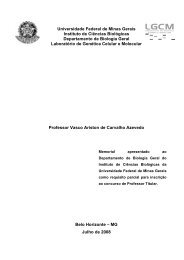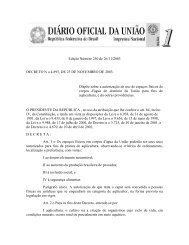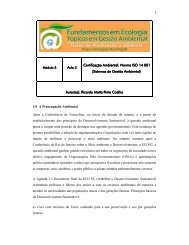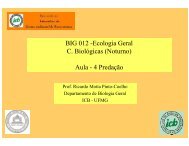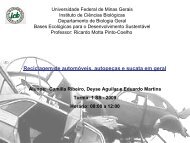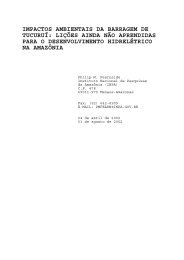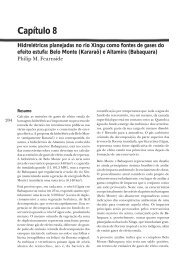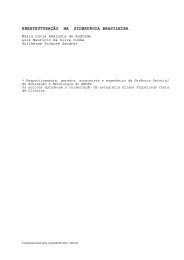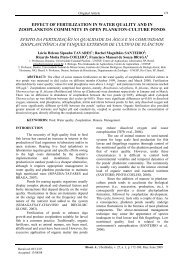guía práctica de experimentos para - Ecologia e Gestão Ambiental
guía práctica de experimentos para - Ecologia e Gestão Ambiental
guía práctica de experimentos para - Ecologia e Gestão Ambiental
You also want an ePaper? Increase the reach of your titles
YUMPU automatically turns print PDFs into web optimized ePapers that Google loves.
Ajuste <strong>de</strong> la proporción N/P:<br />
De acuerdo con la proporción elemental <strong>de</strong> N/P<br />
<strong>de</strong> 16, la proporción <strong>de</strong> la concentración <strong>de</strong><br />
nitrato/fosfato es ca. 10.<br />
Si el agua contiene un nivel elevado <strong>de</strong> fosfato<br />
en com<strong>para</strong>ción a nitrato, Ej., 1 mg/l <strong>de</strong> fosfato y<br />
5 mg/l <strong>de</strong> nitrato, el contenido <strong>de</strong> nitrato tiene<br />
que ser aumentado en consecuencia (10 mg/l).<br />
Aumentar el contenido <strong>de</strong> fosfato, si la<br />
concentración <strong>de</strong> nitrato es elevada. Calcular la<br />
cantidad <strong>de</strong> la solución que se requiere <strong>para</strong><br />
ajustar la proporción N/P tomando el volumen<br />
<strong>de</strong>l acuario en referencia y tener en cuenta<br />
añadir sales (KNO3 = 101.103 g/mol; K2HPO4 =<br />
174.176 g/mol). Añadir el fertilizante y<br />
posteriormente <strong>de</strong>terminar la proporción N/P <strong>de</strong><br />
nuevo. Una proporción N:P entre 10 y 20 es<br />
recomendado <strong>para</strong> reducir el crecimiento <strong>de</strong><br />
algas (véase tabla, números en negrita).<br />
Comprobar y ajustar la proporción N:P durante<br />
el próximo y examinar el efecto <strong>de</strong>l ajuste <strong>de</strong><br />
nutrientes.<br />
5. Organización <strong>de</strong> los datos<br />
Pre<strong>para</strong>r una tabla (véase Tabla 2) incluyendo<br />
los datos <strong>de</strong> las mediciones, las cantida<strong>de</strong>s <strong>de</strong><br />
nutrientes añadidos y los cambios en la<br />
abundancia <strong>de</strong> las algas visibles.<br />
Tabla 2. Tabla <strong>de</strong>l experimento.<br />
Antes <strong>de</strong> agregar :<br />
N (mg/l; mmol/l)<br />
P (mg/l; mmol/l)<br />
Atómico N/P<br />
Añad. Solución Stock<br />
(indicar N o P and ml)<br />
Después <strong>de</strong> agregar:<br />
N (mg/l; mmol/l)<br />
P (mg/l; mmol/l)<br />
Atómico N/P<br />
pH<br />
Abundancia <strong>de</strong> algas<br />
visibles<br />
Más comentarios<br />
6. Analizando los resultados<br />
Día<br />
1 2 5 10 20 30<br />
Pre<strong>para</strong>r un diagrama <strong>de</strong> las series <strong>de</strong> tiempo<br />
medido incluyendo los contenidos <strong>de</strong> nutrientes,<br />
Proporciones N/P y valores <strong>de</strong> pH.<br />
GUÍA PRÁCTICA DE EXPERIMENTOS PARA ECOHIDROLOGÍA<br />
7. Discusión<br />
Discutir los cambios químicos y físico-químicos<br />
en relación al aporte <strong>de</strong> nutrientes y observé la<br />
abundancia <strong>de</strong> algas.<br />
REFERENCIAS<br />
1. An<strong>de</strong>rson D.M., Glibert P.M., Burkhol<strong>de</strong>r<br />
J.M. 2002. Harmful algal blooms and<br />
eutrophication: nutrient sources,<br />
composition, and consequences. Estuaries<br />
25:704-726.<br />
2. Boesch D., Hecky R., O´Melia C., Schindler<br />
DW., Seitzinger S. 2006. Eutrophication of<br />
Swedish Seas. Final Report, Swedish<br />
Environmental Protection Agency,<br />
Stockholm, Schwe<strong>de</strong>n.<br />
3. Dent D.L. 1986. Acid sulphate soils: a<br />
baseline for research and <strong>de</strong>velopment. ILRI<br />
publications 39, Wageningen.<br />
4. Hutchison GE. 1973. Eutrophication.<br />
American Scientist 61:269-279.<br />
5. Koerselman W., Meuleman A.F.M. 1996.<br />
The vegetation N:P ratio: A new tool to<br />
<strong>de</strong>tect the nature of nutrient limitation.<br />
Journal of Applied Ecology 33:1441-1450.<br />
6. Koroleff F. 1983 Determination of<br />
phosphorus. In: K. Grasshoff, M. Ehrhardt<br />
and K. Kremling (eds). Methods of Seawater<br />
Analysis. Verlag Chemie, Weinheim,<br />
Deerfield Beach, FL, Basel. 125-139 pp.<br />
7. Kurmies B. 1972. Zur Fraktionierung <strong>de</strong>r<br />
Bo<strong>de</strong>nphosphate. Die Phosphorsäure<br />
29:118-149.<br />
8. Lake Winnipeg Stewardship Board. 2006.<br />
Reducing nutrient loading to Lake Winnipeg<br />
and its Watershed: Our Respective<br />
Responsibility and Commitment to Action.<br />
Report to the Minister of Water Stewardship<br />
December 2006.<br />
9. Legg J.O., Black C.A. 1955. Determination<br />
of organic phosphorus in soils. 2. Ignition<br />
method. Soil Science Society of America<br />
Proceedings 19:139-143.<br />
10. Lindsay W.L. 1979. Chemical equilibria in<br />
soils. John Wiley and Sons, New York.<br />
11. Lockaby B.G., Walbridge M.R. 1998.<br />
Biogeochemistry. In: M.G. Messina, W.H.<br />
Connor (eds). Southern forested wetlands -<br />
ecology and management. Lewis, Boca<br />
Raton. 149-172 pp.<br />
12. Morgan M.F. 1941. Chemical Soil Diagnosis<br />
by the Universal Soil Testing System.<br />
Connecticut Agricultural Experiment Station<br />
Bulletin. 450 pp.<br />
27




